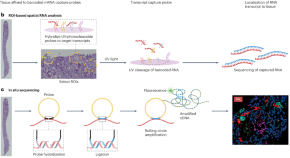Tools and technologies (original) (raw)
Reviews and Perspectives
A guide to studying 3D genome structure and dynamics in the kidney
Here, the authors describe approaches to investigating 3D genome architecture and dynamics. They discuss the physical organization and dynamic regulation of the genome and highlight studies that have provided insights into the roles of genome structure and regulation in kidney health and disease.
Spatial transcriptomics in health and disease
Spatially resolved transcriptomic technologies enable the mapping of transcripts at single-cell or near single-cell resolution in a multiplex manner. This Review describes current and emerging spatial transcriptomic methods, their applications of relevance to kidney biology and remaining challenges for the field.
- Sanjay Jain
- Michael T. Eadon
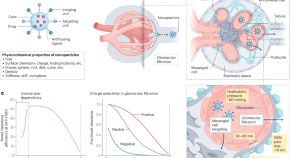
Physiological principles underlying the kidney targeting of renal nanomedicines
Renal nanomedicines may hold promise for the detection and treatment of a variety of kidney diseases. This Review describes how our understanding of the physiological principles that regulate the glomerular filtration, tubular secretion, luminal tubular uptake and re-elimination of nanoparticles in the kidneys may facilitate the selective targeting of nanomedicines to specific segments of the nephron.
- Yingyu Huang
- Xuhui Ning
- Jie Zheng

Advances in CRISPR therapeutics
This Review focuses on the potential applications of CRISPR to treat diseases that cannot be overcome by inducing frameshifts or premature stops in coding genes. The authors discuss Cas protein engineering and CRISPR systems beyond Cas9 that create a toolbox to engineer the human genome.
- Michael Chavez
- Xinyi Chen
- Lei S. Qi
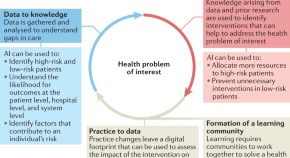
Artificial intelligence-enabled decision support in nephrology
Emerging evidence suggests that artificial intelligence (AI)-enabled decision support systems may have an important role in the diagnosis, prognosis and treatment of kidney diseases. This Review provides an overview of AI fundamentals and the state of the art of AI-enabled decision support systems in nephrology.
- Tyler J. Loftus
- Benjamin Shickel
- Azra Bihorac
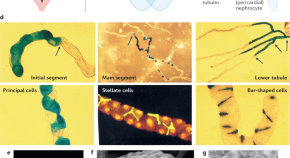
Drosophila melanogaster: a simple genetic model of kidney structure, function and disease
Drosophila melanogaster can be a useful experimental model in nephrology. Here, the authors examine the fly renal system, focusing on the Malpighian tubules and nephrocytes, and discuss its advantages and limitations as a model system and the mechanistic insights into kidney disease that they have provided.
- Julian A. T. Dow
- Matias Simons
- Michael F. Romero

Mapping the human kidney using single-cell genomics
Advances in the field of single-cell genomics and spatial technologies have enabled dissection of the cellular heterogeneity of complex tissues, including the kidney. This Review summarizes the state of the art of single-cell analyses in kidney research, including advances in our understanding of kidney embryogenesis and pathomechanisms of several relevant kidney disease entities.
- Felix Schreibing
- Rafael Kramann
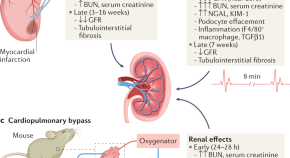
Experimental models of acute kidney injury for translational research
This Review summarizes the state of the art of acute kidney injury model development, focusing on the translatability of discoveries using human kidney organoid, zebrafish, rodent and large animal models. The authors recommend a multidisciplinary approach to optimize the development of effective therapies for acute kidney injury.
- Neil A. Hukriede
- Danielle E. Soranno
- Mark P. de Caestecker
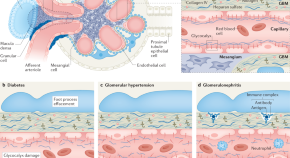
Biomimetic models of the glomerulus
Here, the authors review current approaches to replication of the glomerulus in vitro with a focus on organ-on-a-chip, scaffolding and organoid technologies. They also discuss future directions of research, including the use of newer 3D biofabrication technologies.
- Marta G. Valverde
- Luis S. Mille
- Yu Shrike Zhang

Lipidomic approaches to dissect dysregulated lipid metabolism in kidney disease
Dyslipidaemia is a hallmark of chronic kidney disease (CKD), with insights from lipidomics studies suggesting that alterations in free fatty acid partitioning may contribute to CKD progression. This Review provides an introduction to lipidomics and discusses insights from lipidomics studies of relevance to CKD.
- Judy Baek
- Chenchen He
- Subramaniam Pennathur
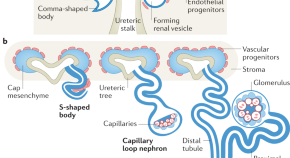
Determining lineage relationships in kidney development and disease
Studies of lineage relationships in the mouse have advanced the understanding of kidney development and repair. Here, the authors discuss these advances as well as how the application of lineage tools to kidney organoids will facilitate studies of human lineage relationships.
- Melissa H. Little
- Sara E. Howden
- Jessica M. Vanslambrouck
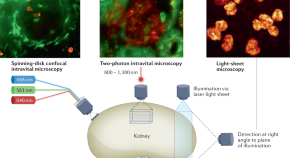
Immune cell behaviour and dynamics in the kidney — insights from in vivo imaging
The actions of immune cells within the kidney are of fundamental importance to kidney homeostasis and disease. This Review describes how live imaging of the kidney microvasculature in animal models has advanced our understanding of leukocyte behaviour in healthy and diseased kidneys.
- A. Richard Kitching
- Michael J. Hickey

Multi-omics integration in the age of million single-cell data
Analyses of single-cell, multi-omics datasets have potential to provide new insights into biological processes; however, the integration of these complex datasets represents a considerable challenge. This Review describes the principles underlying the integration of multimodal data measured on the same cell (that is, matched data) and on different cells (unmatched data), outlining developments in computational methods and data visualization approaches.
- Zhen Miao
- Benjamin D. Humphreys
- Junhyong Kim
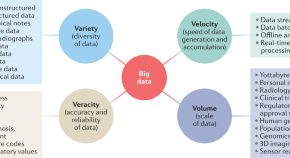
Big Data in Nephrology
Application of big data in nephrology could lead to new insights into kidney diseases, facilitate personalized medicine and improve patient care. This Review discusses the major sources of big data in nephrology and how they could be utilized in research and clinical practice.
- Navchetan Kaur
- Sanchita Bhattacharya
- Atul J. Butte
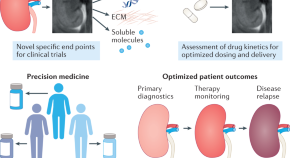
Non-invasive molecular imaging of kidney diseases
In vivo non-invasive molecular imaging techniques have potential to improve clinical research and practices in nephrology. Here, the authors discuss the benefits and challenges of preclinical and clinical applications of molecular imaging to acute kidney injury and chronic kidney disease, transplantation and kidney cancer.
- Barbara M. Klinkhammer
- Twan Lammers
- Peter Boor
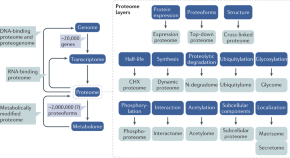
The tissue proteome in the multi-omic landscape of kidney disease
Technological advances continue to expand the use of proteomics in medicine. In this Review, the authors discuss proteomics research findings in nephrology and the potential, as well as the limitations, of using proteomics techniques to uncover disease mechanisms and develop new therapeutic strategies.
- Markus M. Rinschen
- Julio Saez-Rodriguez

Advances in fluorescence microscopy techniques to study kidney function
This Review provides an overview of fluorescence-based microscopy techniques that have been used to study molecular processes within the kidney. The authors describe how the development of cutting-edge technologies has enabled high spatiotemporal resolution of molecular interactions and processes, and how these approaches have aided our understanding of kidney dynamics.
- Suman Ranjit
- Luca Lanzanò
- Moshe Levi
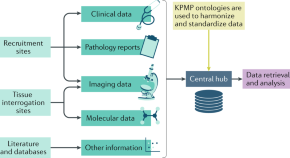
Modelling kidney disease using ontology: insights from the Kidney Precision Medicine Project
Ontologies are powerful tools that facilitate the integration of large and disparate data sets. Here, researchers from the Kidney Precision Medicine Project provide an introduction to ontologies, including those developed by the consortium, describing how these will be used to improve the annotation of kidney-relevant data, eventually leading to new definitions of kidney disease in support of precision medicine.
- Edison Ong
- Lucy L. Wang
- Kidney Precision Medicine Project
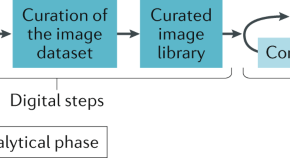
Digital pathology and computational image analysis in nephropathology
Developments in digital pathology and computational image analysis have the potential to identify new disease mechanisms, improve disease classification and prognostication, and ultimately aid the identification of targeted therapies. In this Review, the authors provide an outline of the digital ecosystem in nephropathology and describe potential applications and challenges associated with the emerging armamentarium of technologies for image analysis.
- Laura Barisoni
- Kyle J. Lafata
- Ulysses G. J. Balis
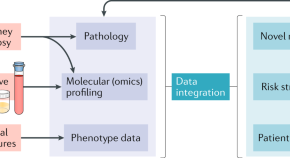
Integrated multi-omics approaches to improve classification of chronic kidney disease
Classification of kidney diseases according to their molecular mechanisms has potential to improve patient outcomes through the identification of targeted therapeutic approaches. This Review provides an overview of the ways in which omics and other data types can be integrated to enhance our understanding of the mechanisms underlying kidney function and failure.
- Sean Eddy
- Laura H. Mariani
- Matthias Kretzler
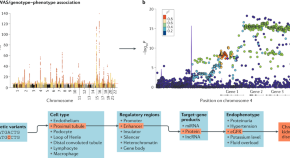
Unravelling the complex genetics of common kidney diseases: from variants to mechanisms
Sullivan and Susztak examine the process of translating data on genetic variants associated with common kidney diseases into information about the underlying disease mechanisms. The authors propose that identification of causal variants, genetic regulatory mechanisms, target-gene products and disease-associated phenotypes is crucial to this process.
- Katie Marie Sullivan
- Katalin Susztak

Using single-cell technologies to map the human immune system — implications for nephrology
In this Review, Stewart and colleagues describe how single-cell technologies, in particular single-cell RNA sequencing, can be used to map the complex immune landscape within organs, and how such technologies might provide insights into the role of the immune system in kidney health and disease pathogenesis.
- Benjamin J. Stewart
- John R. Ferdinand
- Menna R. Clatworthy
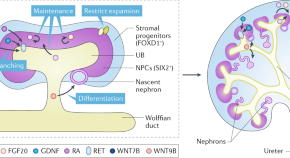
Human kidney organoids: progress and remaining challenges
Kidney organoids have the potential to advance the field of nephrology. Here, the author discusses progress in the development of kidney organoids and describes remaining challenges to the use of these cultures for the study of kidney physiology and disease.
- Ryuichi Nishinakamura
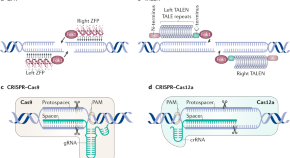
Precision gene editing technology and applications in nephrology
The application of precision gene editing has great potential to accelerate basic research and advance clinical practice in nephrology. Here, the authors discuss this technology and the challenges and potential of genome editing in the kidney.
- Zachary WareJoncas
- Jarryd M. Campbell
- Stephen C. Ekker

Single-cell RNA sequencing for the study of development, physiology and disease
Technological advances are providing unprecedented opportunities to analyse biological systems at the single-cell level. This Review describes the fundamental concepts of single-cell RNA analysis and specific applications of the technology for the study of development, cancer and normal and diseased kidneys.
- S. Steven Potter

Advances in predictive in vitro models of drug-induced nephrotoxicity
Current in vitro nephrotoxicity screens are poorly predictive of toxicity in humans. Here, the authors describe mechanisms of nephrotoxic injury, the functional features of tubular cell models that are essential for predicting the toxicity of pharmaceutical compounds, and novel in vitro cell models under development.
Joanne Y.-C. Soo
Jitske Jansen
Melissa H. Little
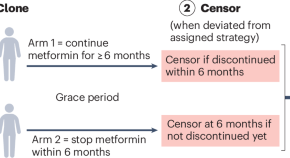
Innovating dialysis through computational modelling of hollow-fibre haemodialysers
Haemodialyser technology has not advanced much in decades, despite its unresolved shortcomings. Sophisticated new computational tools such as high-fidelity surrogate in silico dialyser models could reduce the time and expense of exploring alternative designs, dialysis dose and operating conditions compared with the current gold standard in vitro studies.
- Ruhit Sinha
- Michael V. Rocco
- Anne E. Staples
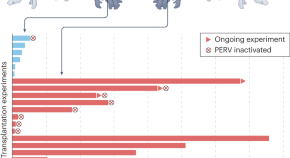
Kidney xenotransplantation edges closer to the clinic
The demand for kidney transplants is far from met by human donors — a problem that may be solved by the clinical translation of porcine kidney xenotransplantation. A new paper describes the development of genetically ‘humanized’ pigs, the kidneys of which kept nephrectomized cynomolgus macaques alive for up to 2 years.
- Eckhard Wolf
- Bruno Reichart
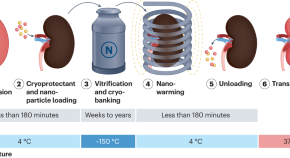
Cryopreservation breaks the organ transplant time barrier
In a ground-breaking development, rat kidneys have been cryopreserved for an unprecedented duration of 100 days and subsequently transplanted successfully after nano-rewarming. This extraordinary achievement opens new possibilities for the field of organ banking.
- Marlon J. A. de Haan
- Ton J. Rabelink
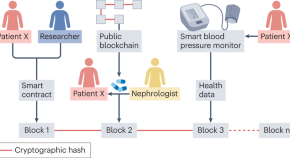
Blockchain in nephrology
Blockchains enable secure data storage, the verification of data origin and accurate registration of changes in information over time. The widespread adoption of blockchain in nephrology could affect clinical practice and research by enhancing the quality of electronic health records and datasets.
- Tamas Szili-Torok
- Daan Kremer
- Martin H. de Borst
Delivering on the potential of measuring nephron number in the clinic
Decades of research have revealed that nephron number is a crucial determinant of kidney health. However, a lack of appropriate tools has limited these studies to ex vivo analyses. For the first time, techniques are emerging that might enable the use of functional nephron number as a biomarker in living humans.
- Kevin M. Bennett
- Edwin J. Baldelomar
- Jennifer R. Charlton
Kidney tissue engineering for precision medicine
The drug development pipeline for kidney diseases is plagued with challenges ranging from an insufficient understanding of disease mechanisms to a lack of robust preclinical models. Bioengineering approaches have the potential to streamline preclinical drug discovery efforts and improve the success of clinical trials for kidney disease.
- Nanditha Anandakrishnan
- Evren U. Azeloglu

Artificial intelligence approaches to improve kidney care
Artificial intelligence is increasingly being used to improve diagnosis and prognostication for acute and chronic kidney diseases. Studies with this objective published in 2019 relied on a variety of available data sources, including electronic health records, intraoperative physiological signals, kidney ultrasound imaging, and digitized biopsy specimens.
- Parisa Rashidi
- Azra Bihorac
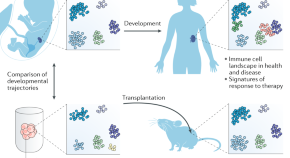
The power of one: advances in single-cell genomics in the kidney
Single-cell genomics provide a powerful approach to investigate the intrinsic complexity of the kidney and understand the diverse cell types and states that exist during kidney development, homeostasis and disease. Several advances were made in 2019 that enhance our understanding of kidney immune cell states in health and disease and the quality of current kidney organoid model systems for studying human diseases.
- Abbe R. Clark
- Anna Greka
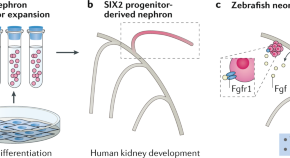
Recreating, expanding and using nephron progenitor populations
2019 saw advances in the generation of induced pluripotent stem cell (iPSC)-derived nephron progenitors and in our understanding of how nephrons form in a kidney organoid. Fundamental studies of regeneration in zebrafish continue to provide vital clues as to how we might use iPSC-derived cells to regenerate a human nephron in vivo.
- Melissa H. Little
- Kynan T. Lawlor
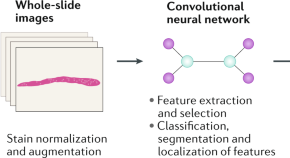
Artificial intelligence in nephropathology
Once confined to the world of science fiction, advances in information technology, particularly in computational and storage resources, have enabled use of artificial intelligence in medicine to become a reality. Two new studies report the use of deep learning — currently the most promising algorithmic artificial intelligence approach — in kidney pathology.
- Peter Boor
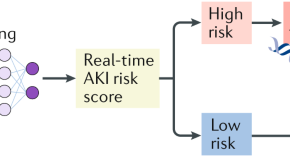
Artificial intelligence to predict AKI: is it a breakthrough?
A new study of deep learning based on electronic health records promises to forecast acute kidney injury up to 48 hours before it can be diagnosed clinically. However, employing data science to predict acute kidney injury might be more challenging than it seems.
- John A. Kellum
- Azra Bihorac

Using and producing publicly available genomic data to accelerate discovery in nephrology
To advance kidney discovery, our community is driven to maximize the utility of genomic data that we all generate. We can best accomplish this through excellence in appropriately incorporating publicly available genomic data into our research efforts and by enthusiastically embracing widespread data sharing in a manner that facilitates its broad use.
- Matthew G. Sampson
- Hyun Min Kang

Single-cell genomics and gene editing: implications for nephrology
Discoveries in 2018 using single-cell sequencing and gene-editing technologies have revealed their transformative potential for the investigation of kidney physiology and disease. Their promise is matched by the speed of their evolution.
- Parker C. Wilson
- Benjamin D. Humphreys
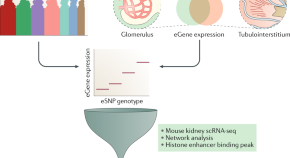
Glomerular and tubulointerstitial eQTLs for genomic discovery
A new study discovered thousands of expression quantitative trait loci (eQTLs) in the renal glomerular and tubulointerstitial compartments and integrated these data with other omics data sets to identify genes with roles in the pathogenesis of chronic kidney disease. This report reinforces the necessity of using compartment-derived eQTLs to advance kidney genomic discovery.
- Matthew G. Sampson
Cellular recording devices imprint the history of the cell
Technologies such as proteomics provide a snapshot of a specific cellular state but are unable to directly record successive signalling events. Two new CRISPR-mediated analogue multi-event recording apparatus (CAMERA) systems enable sequential recording of endogenous and exogenous signalling events by targeted DNA modifications, thereby allowing systematic interrogation of different cellular states.
- Nicholas J. Steers
- Ali G. Gharavi

